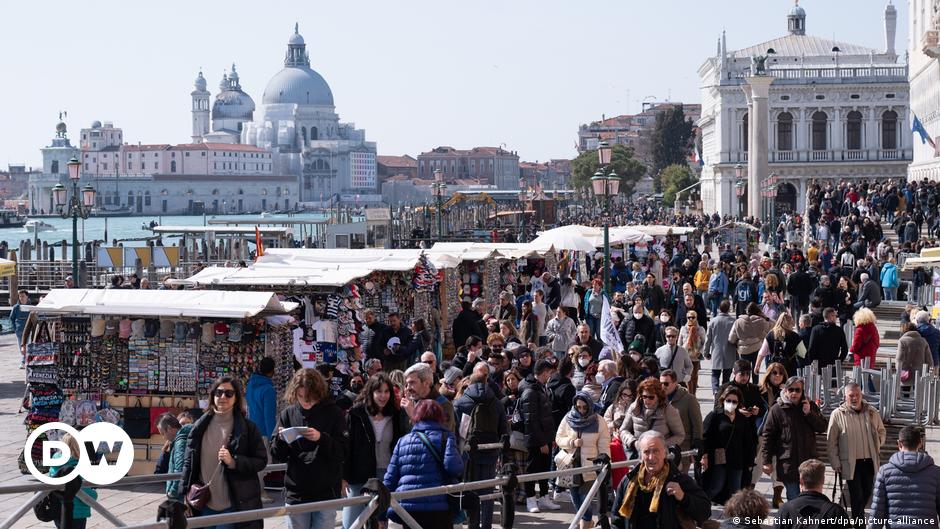Travel
Entry fee for Venice travel: Will it curb mass tourism? – DW – 04/25/2024

This year, the Italian city of Venice will begin charging a €5 ($5.30) fee for day-trippers who are not staying overnight. The trial scheme starts on April 25 and will require tourists to pay a visitor’s fee on numerous different days between the end of April and mid-July.
The scheme’s launch was repeatedly postponed in recent years.
“It’s a great idea,” says Susanne Kunz-Saponaro, who lives in Venice and works as a local tour guide. “But it doesn’t seem really well thought-out.” She doubts the city’s efforts to curb mass tourism will have much effect.
The problem is that a number of exceptions could undermine the new scheme.
Residents of the wider Veneto region, for example, who visit Venice don’t have to pay a fee. And it is completely unclear how city authorities intend to check that all day-trippers really have paid up. Officials have said, however, that inspectors will be out and about carrying out spot checks. Anyone caught without having paid the fee risks a fine of up to €300, they say.
Tour guide Kunz-Saponaro is most troubled by the fact that the scheme does not set a maximum number of tourists allowed to the city visit per day. After all, on average, around 80,000 holidaymakers stream into Venice every day, most of whom only spend a few hours before returning. It has been shown that day-trippers spend relatively little money in the city and crowd the city’s narrow alleys.
“My hair stands on end at the thought of groups of tourists clogging up alleyways when I have to pass by with my shopping bags,” Kunz-Saponaro told DW. “The situation is hard to deal with.”
Venice wants tourists to stay overnight
City officials have been trying to get a handle on mass tourism in the city.
“We invite those who want to visit our city to experience Venice at a slow pace and get a feel for the city,” Venice’s city councilor for tourism, Simone Venturini, told DW. Transforming Venice tourism will, however, take time, he concedes. Venturini said the city was introducing a visitor’s fee to encourage tourists to stay overnight. Venice is the first city to take such a step, and adjustments would be made with time, added the city councilor.
Venice Mayor Luigi Brugnaro recently told the daily Corriere della Sera that the city will remain open to visitors without a cap on how many people are allowed to visit any given day. He added that the fee may, however, have a psychological effect by deterring some tourists.
“Venice must be suited to those who live there and those who visit,” Brugnaro said. “But on certain days with particularly high visitor numbers, there is a risk this is not the case.”
Before the COVID-19 pandemic, five million tourists visited Venice every year. A similar figure is expected for this year.
Fighting overtourism
In recent years, Venice residents and lawmakers have complained about rude visitors lacking common decency. City officials have drawn up a list of rules to encourage better manners. Among other things, it is forbidden to sit on Venice bridges and stairs, jump into the canal, walk through the city in swimwear, feed pigeons or litter. Anyone breaking these rules could face fines of up to €500.
According to city administrators, there is no data on how often holidaymakers are fined, who say raising money is not the primary objective. They say the purpose of the visitor’s fee is not to generate cash, though expect it could contribute around €700,000 to city coffers this year. City officials say this money and revenue generated from overnight stay taxes will be used to clean streets and improve touristic offerings.
Holidaymakers staying in Venice accommodation need to pay a nightly fee of between €1 and €5 per night, depending on the hotel category and time of year. Last year, the city made €34 million from this tax alone.
That’s not all. As of August 1, new rules will also apply to guided city tours. Tourist groups may exceed no more than 25 people. In addition, greater care will be taken to ensure that locals are not bothered by tourists blocking alleyways as they listen to tour guides.
Local guide Kunz-Saponaro, however, thinks this new regulation does not go far enough and would prefer a limit of no more than 20 tourists at any given time. She mainly shows smaller groups around Venice and concedes that “tourism is important for the city.”
That said, making money should not be the number one objective, according to Kunz-Saponaro. “The people who live in Venice must be able to cope with city tourism.”
This article was translated from German.







/static.texastribune.org/media/files/f5fdb1dff4d6fd788cba66ebaefe08d0/Paxton_GOP_Convention_2018_BD_TT.jpg)

